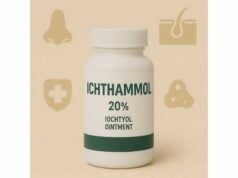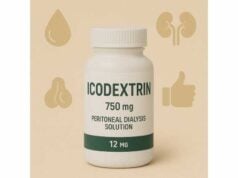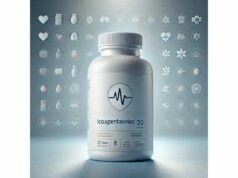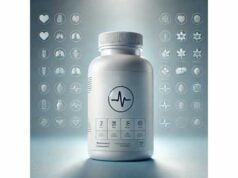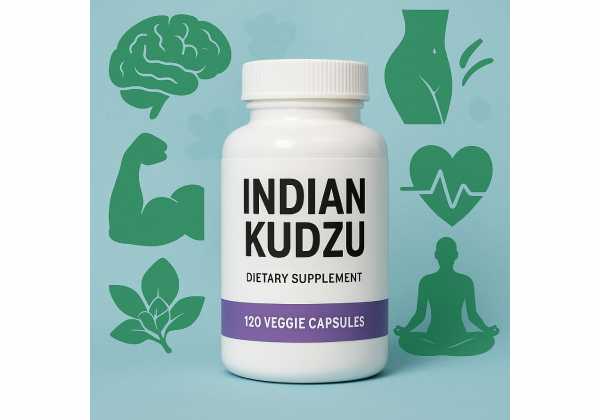
Indian kudzu (Pueraria tuberosa), also called vidari kand in Ayurveda, is a climbing legume with starchy underground tubers and a long record of food and medicinal use across the Indian subcontinent. The tuber is naturally rich in isoflavones (such as puerarin, daidzein, and genistein), sterols, and antioxidant phenolics, and it’s classed traditionally as a nourishing, strength-building “rasayana.” Today, interest in Indian kudzu spans metabolic wellness, menopausal comfort, reproductive health, and exercise recovery. While some effects are supported mainly by preclinical research or polyherbal trials, the plant’s chemistry overlaps with better-studied kudzu relatives, and a cautious, food-first approach can make sense for people seeking a gentle tonic rather than a fast-acting drug. This guide translates the tradition and the emerging science into practical steps—what Indian kudzu might help, how to choose a preparation, sensible dosage ranges, who should avoid it, and how to use it safely alongside modern care.
Quick Overview
- Supports nourishment, recovery, and menopausal comfort with isoflavones and antioxidant compounds.
- Typical adult ranges: 1–3 g/day whole-tuber powder with food; 250–500 mg/day standardized extract; up to 6 g/day powder short term if well tolerated.
- Safety caveat: isoflavones may act weakly estrogenic and can alter how some medicines are handled; monitor with a clinician if you take prescriptions.
- Avoid during pregnancy and breastfeeding, in children, with estrogen-sensitive cancers, severe liver disease, or when using narrow-therapeutic-index drugs without medical guidance.
Table of Contents
- What is Indian kudzu?
- Benefits: where it may help
- How to use: forms and prep
- Dosage: practical ranges and timing
- Safety, side effects, interactions
- Mistakes, troubleshooting, and use cases
- Evidence: what the research says
What is Indian kudzu?
Identity and names.
Indian kudzu is the common name for Pueraria tuberosa (Fabaceae), known in Ayurveda as vidari kand. It’s distinct from East Asian kudzu (Pueraria montana var. lobata) but shares some chemistry, including the isoflavone puerarin. The plant is a perennial climber with large, edible tubers traditionally used as food and medicine.
Traditional roles.
In classical Ayurvedic texts and regional practices, vidari is classified as a rasayana—a nourishing tonic used to restore strength after illness, support reproductive vitality, soothe tissue dryness, and help with heat and irritation. It appears as a standalone powder and within compound formulas aimed at convalescence, menopausal comfort, and weight gain when undernourished.
Key constituents (what’s inside).
- Isoflavones: puerarin, daidzein, genistein—weakly estrogenic, antioxidant, and vasomodulatory.
- Phenolics and flavonoids: quercetin, isoorientin, mangiferin—scavenging free radicals, modulating inflammatory pathways.
- Sterols and saponins: β-sitosterol, stigmasterol—supportive to lipid balance and cell-membrane integrity.
- Starch and prebiotic fibers: contribute to the food/nourishing aspect of the tuber.
How the chemistry links to effects.
- Menopausal support: Isoflavones can engage estrogen receptors with a fraction of estrogen’s potency, helping balance hot flashes and bone turnover in preclinical models.
- Nourishing recovery: The starchy tuber with bioactives aligns with traditional use in convalescence, where caloric density plus antioxidant support is desired.
- Metabolic tone: Animal and polyherbal studies suggest benefits for lipids and glucose handling; human data remain early but directionally positive in specific contexts.
- Tissue comfort: Antioxidant and anti-inflammatory actions may contribute to joint and muscle ease when paired with sleep, protein adequacy, and movement.
Whole tuber vs. extract.
- Whole-tuber powder (culinary/tonic): broader nutrient and phytochemical profile, gentler effects.
- Standardized extracts: concentrate specific compounds (often puerarin or total isoflavones) for targeted goals like menopausal comfort or metabolic studies. Labels should state standardization (e.g., “20% isoflavones” or “10% puerarin”) and show batch testing for purity.
Quality checklist.
Choose products that list the botanical name (Pueraria tuberosa), plant part (tuber), and standardization (for extracts). Prefer brands that publish Certificates of Analysis (heavy metals, pesticides, microbiology) and identify country of origin and harvest/lot numbers.
Benefits: where it may help
1) Menopausal comfort and bone support
Preclinical and translational work with P. tuberosa fractions rich in antioxidant isoflavones shows promising effects on markers of bone density and strength, likely via gentle estrogen-receptor engagement and oxidative-stress reduction. Although these are not one-to-one substitutes for hormone therapy, many midlife women pair a food-first tuber powder or moderate extract with a lifestyle plan emphasizing protein, vitamin D, calcium, and resistance exercise. Expect gradual effects over 8–12 weeks rather than rapid symptom relief.
2) Nourishment during recovery and low appetite
In convalescence or periods of under-nutrition, Indian kudzu’s starchy tuber provides calories plus phytochemicals that may help the body rebuild. In traditional practice, it appears as a milk-based porridge or ghee-infused paste to improve caloric density and palatability. Modern users sometimes blend ½–1 teaspoon powder into warm cereals or smoothies to make meals easier to tolerate when appetite is poor.
3) Metabolic support (adjunctive)
Polyherbal trials and mechanistic work suggest favorable shifts in lipid oxidation, glycemic handling, and inflammatory tone. In real life, that translates to using Indian kudzu as an adjunct to the fundamentals: earlier dinners, high-fiber plates, 7–9 hours of sleep, and daily movement. For people already consistent with these basics, adding a 250–500 mg/day extract can be a low-risk experiment for 6–8 weeks, tracking fasting glucose, waist circumference, or non-HDL cholesterol.
4) Exercise recovery and body composition (food-first)
Ayurvedic use places vidari as a strength and weight builder for underweight individuals and those recovering from illness. Combined with resistance training and adequate protein (1.2–1.6 g/kg/day), the tuber’s carbs plus isoflavones may support better training tolerance and subjective recovery, especially in people who “run cold and dry” (low appetite, slow weight gain, poor sleep). Avoid high doses if you’re prone to reflux or bloating.
5) Men’s and women’s reproductive wellness (context-specific)
Traditional claims include spermatogenic support in men and tonic effects for female reproductive tissues. Modern evidence remains preliminary. If your goals involve fertility or hormonal balance, coordinate with a clinician—especially if you have estrogen-sensitive conditions or are using fertility treatments where precise hormonal control matters.
What Indian kudzu is not
- It’s not a stand-alone therapy for osteoporosis, diabetes, cardiovascular disease, or infertility.
- It will not replace prescription therapies when those are indicated.
- It’s not appropriate for pregnancy or breastfeeding in supplemental forms due to estrogenic potential.
How to use: forms and prep
Whole-tuber powder (most food-like)
- What it is: Finely milled dried tuber; flavor is mild, slightly nutty.
- How to take: Stir ½–1 teaspoon (≈1–3 g) into warm porridge, soups, stews, or smoothies, once daily with food. Increase slowly every 3–4 days if well tolerated.
- Who it suits: People seeking a gentle, nourishing tonic, underweight or recovering individuals, and those prioritizing food-first strategies.
Standardized extract (targeted use)
- What it is: Capsule or tablet standardized to puerarin or total isoflavones.
- How to take: Typical 250–500 mg/day, taken with a meal. Some protocols use split dosing (morning and evening) for steadier exposure.
- Who it suits: Those pursuing menopausal comfort, bone support, or metabolic adjuncts with a compact capsule count.
Traditional preparations (examples)
- Vidari ghee (restorative): Simmer 2 tbsp ghee with ½ tsp Indian kudzu powder and a pinch of cardamom for 2–3 minutes on low; swirl into warm rice or dal at dinner.
- Warm vidari milk: Heat 200 ml milk (or fortified plant milk) with ½–1 tsp kudzu powder and a sliver of fresh ginger; whisk until smooth. Sweeten lightly with date syrup if needed.
- Convalescent porridge: Combine 1 tsp kudzu powder, oats, and water; cook until glossy; add a spoon of yogurt when cool for extra protein and gut-friendly cultures.
Stacking and pairings
- With bone-support basics: vitamin D3 (1,000–2,000 IU/day), calcium (through food), and resistance training (2–3×/week).
- With metabolic habits: 25–38 g/day dietary fiber, early time-restricted eating if appropriate, and daily walks.
- Avoid stacking with multiple estrogenic botanicals (e.g., high-dose red clover, high-soy supplements) without supervision; you can overshoot.
Buying and storing
- Look for the botanical name, plant part (tuber), and standardization on extracts (e.g., “20% isoflavones”).
- Ensure COAs show heavy metals, microbial counts, and pesticide screens within limits.
- Store powders in an airtight container away from heat and light; use within 6–9 months for best potency.
Dosage: practical ranges and timing
Adults (general guidance)
- Whole-tuber powder (food-first): 1–3 g/day with meals. If needed and well tolerated, short courses up to 6 g/day (in 2–3 divided doses) are common in traditional practice.
- Standardized extract: 250–500 mg/day, taken with food. If the label lists puerarin or total isoflavones, stay within the manufacturer’s suggested limit; more is not necessarily better.
- Course length: Evaluate effects after 6–8 weeks; continue if beneficial and well tolerated. For a “build and break” rhythm, consider 8 weeks on / 2 weeks off.
Menopausal comfort and bone support
- Pair 250–500 mg/day extract or 2–4 g/day powder with vitamin D, adequate calcium through diet, and strength training. Bone remodeling is slow; meaningful changes require months of consistent habits.
Recovery and weight gain (under-nourished adults)
- Start 1 g/day, then increase by 0.5–1 g every 4–7 days while ensuring protein 1.2–1.6 g/kg/day, enough sleep, and gentle progressive resistance exercise. Stop if reflux, bloating, or unusual swelling occurs.
Timing and absorption
- Take with breakfast or lunch if it feels energizing; evening if it feels calming. Always pair with food to minimize GI upset and support steady absorption.
- Hydrate well—phytoactive powders can be drying if fluids are low.
Older adults
- Start low (0.5–1 g/day powder or 250 mg/day extract) and advance slowly while monitoring for reflux, constipation, or dizziness.
Who should not use supplemental forms
- Pregnancy and breastfeeding: avoid due to estrogenic potential.
- Children and adolescents: avoid supplements; culinary use only if culturally customary and minimal.
- Estrogen-sensitive cancers or conditions: avoid unless an oncology team approves.
- Advanced liver disease: avoid or use only with specialist supervision.
Safety, side effects, interactions
Common, usually mild
- Digestive: fullness, mild nausea, or bloating when starting—reduce the dose, take with food, and increase fluids.
- Headache or flushing if you escalate doses quickly or stack with other phytoestrogens.
Less common but important
- Reflux/heartburn—more likely with large bedtime doses; move intake to earlier in the day or lower the dose.
- Menses changes—spotting, cycle length shifts, or breast tenderness may signal sensitivity to isoflavones; stop and discuss with a clinician.
Potential interactions
- Hormone-sensitive conditions: Isoflavones can weakly activate estrogen receptors; individuals with ER-positive cancers, endometriosis, or uterine fibroids should avoid supplemental Indian kudzu unless cleared by their care team.
- Liver and drug handling: Animal and clinical work with kudzu isoflavones (notably puerarin) shows hepatic metabolism and antioxidant actions; if you take narrow-therapeutic-index drugs (e.g., certain antiarrhythmics, calcineurin inhibitors, some anticoagulants), involve your prescriber and pharmacist before adding standardized extracts.
- Anticoagulants/antiplatelets: Isoflavone-rich extracts may modestly influence platelet function or drug metabolism in sensitive individuals—monitor appropriately.
- Thyroid: As with other isoflavones, theoretical concerns exist about thyroid hormone handling when iodine is insufficient; maintain adequate iodine and selenium through diet if you use isoflavone supplements regularly.
Stop and seek care if
- You experience severe abdominal pain, persistent vomiting, yellowing of eyes/skin, dark urine, chest pain, fainting, or signs of allergic reaction (hives, wheezing, swelling).
Practical safety tips
- Start low, go slow. Increase only after 3–4 days without issues.
- One new thing at a time. Introduce Indian kudzu separately from other supplements to read your response.
- Keep your clinician in the loop—especially if you use prescriptions, have a cancer history, or plan procedures.
- Cycle if using extracts continuously (e.g., 8 weeks on / 2 weeks off) and reassess need.
Mistakes, troubleshooting, and use cases
Frequent mistakes
- Equating all “kudzu” products. Indian kudzu (P. tuberosa) differs from East Asian kudzu (P. montana var. lobata). Some human trials involve puerarin or kudzu extracts from East Asian species; don’t assume identical effects or doses.
- Ignoring the base plan. Vidari is a tonic—its best use is alongside sleep, protein, fiber, resistance exercise, and sunlight.
- Chasing rapid hormone shifts. Isoflavones are gentle modulators, not hormone replacements.
- Stacking multiple phytoestrogens (red clover, high-dose soy, kudzu extract) without oversight.
Troubleshooting tips
- Bloating or heaviness: cut the dose by half, switch to capsules, and take earlier in the day with warm fluids.
- No noticeable effect after 8 weeks: ensure lifestyle basics are solid; if the goal is menopausal comfort, consider non-phytoestrogen options (e.g., magnesium glycinate for sleep, aerobic training for hot flashes) and speak with a clinician.
- Cycle irregularity or breast tenderness: pause use and consult your healthcare provider—this signals sensitivity to isoflavones.
Use-case snapshots
- Midlife bone care beginner: 250 mg standardized extract with breakfast; three 30-minute strength sessions/week; vitamin D repletion per labs; reassess bone markers and symptoms at 12 weeks.
- Convalescent appetite rebuild: 1 g powder in warm porridge each morning, 0.5–1 g added weekly if tolerated; target 1.4 g/kg/day protein, lights-off by 10:30 pm; review energy and weight after 4 weeks.
- Metabolic adjunct: 250–500 mg extract daily for 8 weeks, alongside 25–38 g/day fiber and post-meal walks; track waist, fasting glucose, and triglycerides.
Evidence: what the research says
What’s strongest right now
- Comprehensive modern reviews catalog the chemistry and broad pharmacology of Pueraria tuberosa, highlighting isoflavones (puerarin, daidzein, genistein), flavonoids, and sterols with antioxidant, anti-inflammatory, metabolic, and tissue-protective actions in preclinical models.
- Antioxidant-enriched fractions of P. tuberosa show anti-osteoporotic effects in ovariectomized rats and in vitro activity against certain hormone-sensitive cancer cell lines—promising, but not definitive for humans.
- Puerarin, an isoflavone shared across the Pueraria genus, has a growing human literature (mostly from East Asian kudzu) in cardiometabolic and neurological settings, including randomized trials and meta-analyses with oral and injectable forms in specific clinical contexts. Extrapolation to Indian kudzu requires caution but supports the plausibility of some traditional uses.
What remains early or mixed
- Menopausal symptom relief: Human data specific to P. tuberosa are limited; benefits likely hinge on total isoflavone intake, overall diet, and exercise.
- Metabolic and weight outcomes: Signals exist from polyherbal regimens and preclinical studies; high-quality human trials isolating P. tuberosa are still sparse.
- Reproductive outcomes: Traditional claims (e.g., spermatogenic support) need larger, well-controlled human trials.
How to read this as a user
- The direction of evidence argues for food-first, moderate-dose Indian kudzu as a tonic, not a substitute for medical therapy.
- Combine with habit anchors (sleep, protein, fiber, strength training).
- If you take medications or have hormone-sensitive conditions, involve your clinician before using standardized extracts.
References
- Pueraria tuberosa: A Review on Traditional Uses, Pharmacology, and Phytochemistry 2021 (Review)
- A fraction of Pueraria tuberosa extract, rich in antioxidant compounds, alleviates ovariectomized-induced osteoporosis in rats and inhibits growth of breast and ovarian cancer cells 2021 (Preclinical Study)
- Puerarin: a hepatoprotective drug from bench to bedside 2024 (Review)
- Effects of Puerarin on the Prevention and Treatment of Cardiovascular Diseases 2021 (Review)
- Pueraria tuberosa: a review on its phytochemical and pharmacological profile 2014 (Review)
Disclaimer
This content is for educational purposes only and does not replace personalized medical advice, diagnosis, or treatment. Indian kudzu can interact with health conditions and medicines—especially those affected by hormones or processed through the liver. Do not use supplemental forms during pregnancy or breastfeeding, in children, or with estrogen-sensitive cancers unless your clinician approves. If you experience severe or unexpected symptoms, stop use and seek medical care promptly.
If this guide helped, please consider sharing it on Facebook, X (formerly Twitter), or your favorite platform, and follow us for future evidence-informed wellness articles. Your support helps us keep creating practical, people-first resources.

